With the advent of exceptional display units, there is an increasing necessity for better video interfaces and display controllers.
Due to this growing requirement fordisplay quality, the older and relatively low signal-quality VGA interface is now on the verge of extinction. It has now been almost completely replaced by the superior HDMI interface.
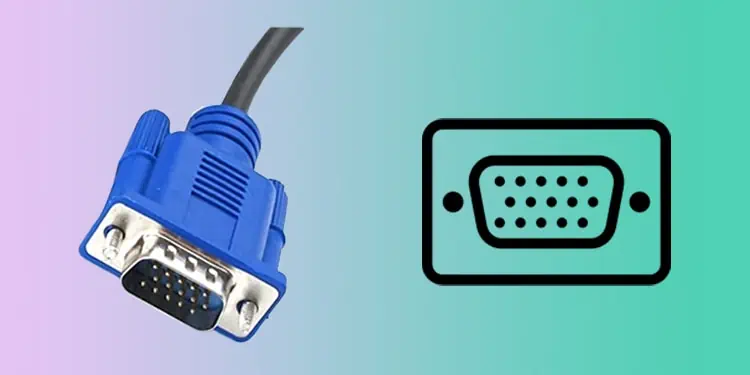
Nevertheless, there are still devices and display unit that consists of the VGA. And it still has its significance in a few areas. So, how exactly does the VGA vary from the HDMI interface? And which one should you choose? Let’s find out.
VGA
VGA, or the Video Graphics Array, is one of the oldestdisplay connectionsdeveloped by IBM, which came to use in the late 80s IBM computer. It transmits the video signal inanalog form. This display controller has been the common type of interface to transmit video signals to the monitor, and almost every display device incorporates one.
The VGA connector consists of abulky design with 15 pinsdivided into three rows. It works by transmitting the Red, Blue, and Green video signals along with Vertical and Horizontal sync information. In the later upgrades, it also consisted ofVESA signalsto identify the type of display units as well.
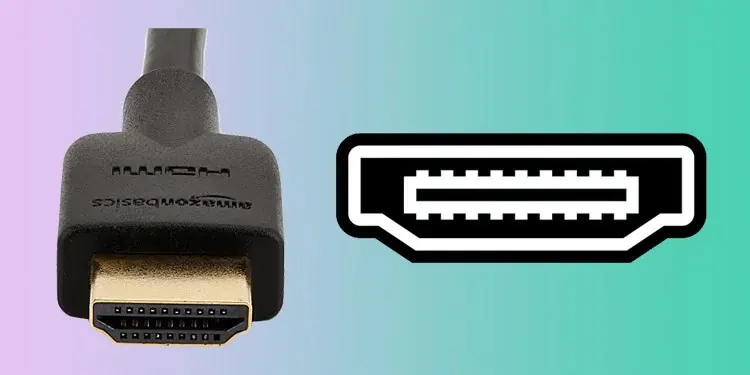
VGA has received several upgrades from different manufacturers with improvements in maximumresolution support for monitorsand signal quality. These are named VGA, SVGA, XGA, SXGA, UXGA, QXGA, etc.
HDMI
HDMI, or High-Definition Multimedia Interface, was the first display controller to transfer both digital visual and audio signals using a single cable. Released in 2002, theHDMI interfacehas now become a norm in almost all monitors, gaming consoles, and other display units.
The commonly used Type-A HDMI, among the five types,consists of 19 pins. These pins are responsible for transmitting the audio, video, and pixel clock data after being inserted into an HDMI port. It works as per the principle ofTransition Minimized Differential Signaling, or TMDS, which divides the video signal into pixels and uses links to transmit the RGB color and the divided pixels as a pixel clock.
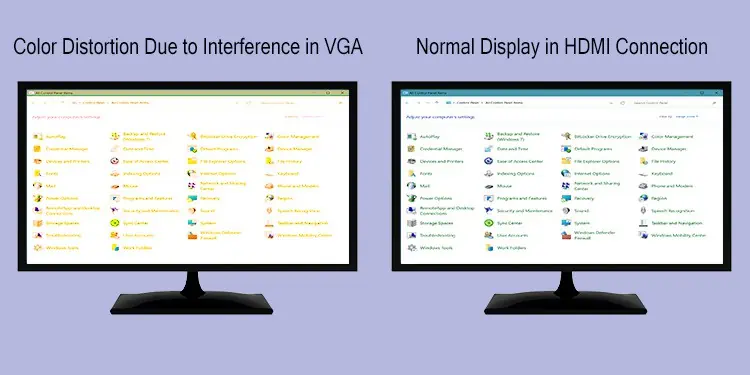
HDMI has also received several upgrades after HDMI 1.0, with 2.1 being the recent one, withsuperb bandwidthand support for the highestrefresh rateand resolution.
VGA Vs. HDMI – Specific Features
The major difference between the VGA and HDMI interfaces is in their image quality, with HDMI being the better one.
Similarly,HDMI is hot-pluggable, meaning you can insert or remove it while the system’s running, and you won’t experience any disturbance in the signal. However, the image quality will degrade, or thedisplay may not even show upif you try hot-plugging the VGA connector.
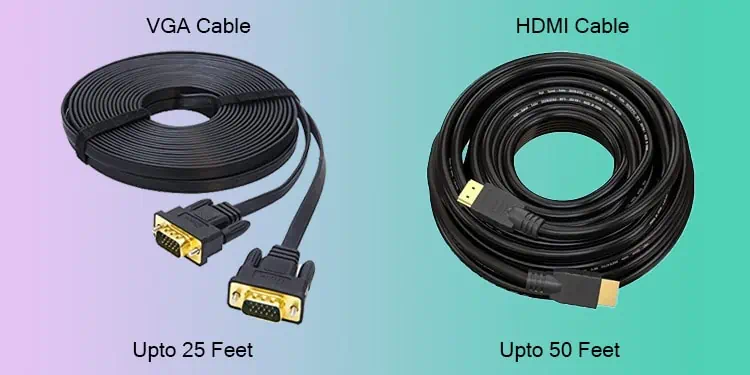
Besides these, let’s discuss what features and functionality separate these two interfaces.
Bandwidth, Resolution, and Refresh Rate
VGA connection can transfer the video signal data at the rate of14 to 116 MegaHertz. This bandwidth varies for different versions, with VGA having the lowest transfer rate and UXGA the highest.
As per the bandwidth, the standard VGA version supports adisplay resolution of up to 640 x 480. While the QXGA version can provide a maximum resolution of 2048 x 1536. Similarly, the standard VGA interface can attain a refresh rate of up to only 60 Hz.
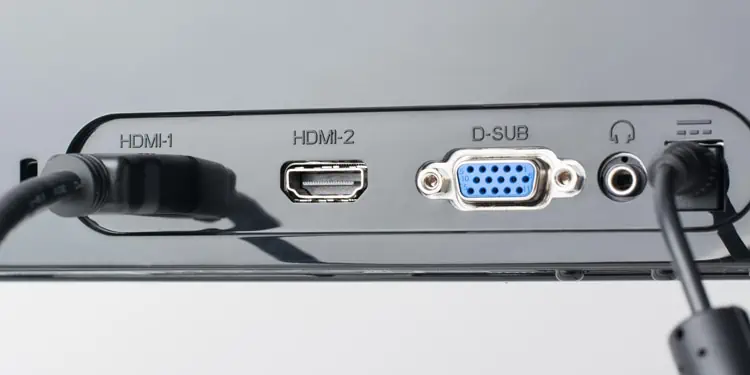
Nevertheless, for the upgraded VGA versions, one can obtain a slightly higher refresh rate of up to 85 Hz for a lower-resolution display.
Looking at the HDMI interface, the commonly available HDMI 2.0 can transfer the signal atup to 18 Gbps, while HDMI 2.1 have a transmission rate of whooping 48 Gbps. It evensurpasses the faster DisplayPort1.4.
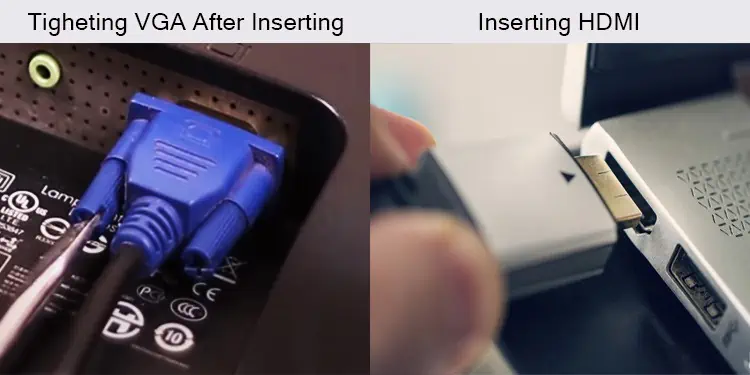
Not only this, you can achieve a maximum resolution of 8K and arefresh rate of 240 Hz for 1080p resolution. Let’s have a quick look at the bandwidth, resolution, and refresh rate for the two interfaces.
Input Lag
Input lag is the time elapsed between the reception of a signal and its appearance on the screen. In the case of the HDMI interface, thedigital signals are post-processedin terms of color and other effects for better image quality. But the analog signals from VGA are shown as they are received. This post-processing cancause a slight input lagin HDMI.
However, the lag is not that significant. It is in a few milliseconds, and you would not even find any differences. To add to this, when you use a VGA connection in a digital display unit, the analog VGA signals also take a while toget converted into digital signals. Thus, the VGA interface also seems to have input lag.
Also, the input lag mostlydepends upon the monitor and display unitrather than the connection type. So, if we look at the imperceptible time of lag, Input lag and latency do not make much of a difference.
Interference and Signal Quality
Talking about signal quality, the VGA interface experiences a lot ofsignal interference from other system components. This is because the VGA carries the information in the analog signal, and thesepick up noise from other cablesand electrical parts of the computer.
In the past, most of electronic devices used a VGA interface. So, to lower the interference, the VGA cable is provided with a cylindrical extrusion. Similarly, theI/O Shieldat the back of the motherboard alsoprevents signal interferencefrom internal components and other cables of the PC.
But there is no such signal interference in HDMI from the internal units and computer cables. However, there is still a chance ofslight electromagnetic interference in the HDMI cable itselffrom other electronic units in the area. And the cylindrical beads are used to lower the disturbance.
Audio
HDMI interface is able to transfer both audio and video from the same cable and port. It evensupports up to 32 channels of audio signals and HD Audio, such as DTS and Dolby.
However, VGA isable to transmit only the video signal. You will need an additional audio cable and port on the system to share the sound. Even after using a VGA to HDMI converter, you will have to get an additional audio cable to get the sound signals.
Cable Length
VGA cables can transmit image and video signals in their original qualitywithin a distance of 25 feet. Beyond that, the signal quality starts to degrade. However, there are VGA cables longer than 150 feet in the market though you won’t get better quality.
But the recommended length of anHDMI cable is up to around 50 feetor 15 meters, up to which you won’t experience any quality degradation.The digital signals in the case of HDMI do not get losta lot in comparison to the VGA analog signals.
The higher quality signals, refresh rate support from the HDMI and its longer cable length make it the ideal choice for display at a farther distance.
Compatibility and Application
VGA interfaces are mostly compatible andfound in older displaysand gaming consoles. You may not find an HDMI port in those systems. So, if you possess such hardware, then you may want to use the VGA, and the HDMI cables might be useless. In addition to those systems, the projectors still use the VGA interface.
Similarly, you can findHDMI in modern displays, consoles, TV, and other electronics. Almost all display and audio-needing devices are HDMI-friendly nowadays. Yes, some of these systems still provide one VGA port, but the transition is getting faster due to the excellent signal quality of HDMI. So, VGA cables have becomepretty much obsoleteat the present time.
So, while HDMI is almost used in every display unit, VGA is mostly employed for amulti-monitor setup, screen projection, etc.
Having said that, there are converter cables available in the market, such asVGA to HDMIand HDMI to VGA. You can use these to use a VGA cable on an HDMI port and vice versa.
Convenience
Being a bulky design, the VGA connectorneeds to be locked into the port with two pins on its side. Without the lock, the connector gets loosened easily, hence, distorting the image quality and color. Sometimes, the display will not even come up on the screen. This makes theVGA quite inconvenientas you need to make sure of a tight connection behind both the monitor and the system.
However, theHDMI does not require such pinsto tighten it. You can simplyinsert the connector to the monitorand the motherboard or GPU, and it does not easily come off as well. There is a chance of a loose connection, but it is quite unusual. And you do not have to worry about having the video signal disturbed.
Price
Being the oldest type of display interface,VGA cables are quite cheapand easily available in the market. HDMI cables are quite costlier than VGA. The cost of the new HDMI 2.1 cable, with its fastest bandwidth, is incomparable with the old and slow VGA cable.
But nowadays, you canfind a cheaper HDMI cable of an earlier versionin the market. And they do a fine job in comparison to the VGA cables.
Are There Any Similarities?
Besides both being a display controller and interface forvideo signal transfer, there are not many similarities between VGA and HDMI.